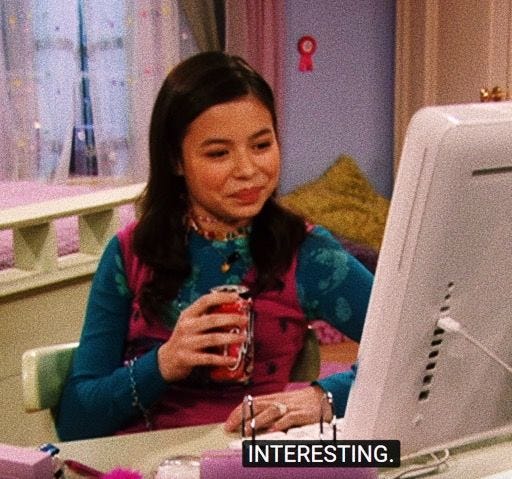brave enough is a newsletter about finding balance between technology, nature and modern life. Join the club ❤️🔥
Lately I’ve been thinking a lot about desktops. I’m not talking about laptops connected to a monitor – I mean the real deal.
The humble desktop played a major role in my adolescence. To understand its influence, we need to journey all the way back to 1999.
The internet had just arrived in rural Ireland in the form of a sinfully ugly, off-white Dell desktop. “The internet” was fixed in place, imprisoned in the desktop, and therefore had to be shared. You could go on the internet for an hour – but then it was your sister’s turn.
Throughout the late 90s and early 00s, it became common for everyone’s house to have what we oh-so-creatively called the computer room. Usually the smallest room of the house, it was a former office or storage closet where the desktop had been installed like a spaceship that had just touched down on earth.
There was no Wi-Fi in those days - instead, you had to sit through the modem gurgling its way through the dial up connection. This is a crucial detail: you had to disconnect from the internet whenever someone wanted to make a phone call on the landline. Many angsty preteen tears were shed over this, as sadly my parents couldn’t fathom just how vital it was for me to reply immediately to my school friends sharing Blink 182 lyrics on MSN Messenger.
Desktops made going on the internet a deeply social activity. Your friends would come over and you would go on the computer – together – interactively exploring the content you found. You would play PC games with your cousins and siblings. When alone, you would search for funny websites that you could share with your friends later.
I now look back on this era with increasingly fuzzy nostalgia because it was tragically short-lived. The way we used the internet in our personal lives began to radically change thanks to the simultaneous arrival of high speed internet, smartphones and social media. Suddenly, the internet was fast and omnipresent, less of a dedicated activity and more of a continuum. It followed us when we left the house, our smartphone became a body part. The internet also became increasingly insular. Instead of sharing the internet with your friends, you spent your time constructing a second life – on its surface a shiny online identity, and below that a private pool of DMs and Google searches of your deepest secrets.
This, in my opinion, is really where our use of the internet took a nosedive. What’s most fascinating is that this isn’t just anecdotal – it’s shown in data. In Jonathan Haidt’s latest book, The Anxious Generation, he explains that during the pre-smartphone period (1990-2010), Millennials' mental health actually improved compared to the previous generation: “The 1990s saw a rapid increase in the paired technologies of personal computers and internet access, both of which could be found in most homes by 2001. Over the next 10 years, there was no decline in teen mental health. Millennial teens, who grew up playing in that first wave, were slightly happier, on average, than Gen X had been when they were teens.” It was poor Gen-Z whose adolescence unfolded in the digital wild west of the 2010s, kicking off a mental health crisis that continues to this day.
I’ve written about how social media and engagement-based algorithms have made the internet deeply lame. What’s more, our always-on culture is literally powered by the smartphones. You’re expected to reply instantly, always stay informed, and read notifications about the latest terrible events unfolding half a world away. While I’m no zealot and love technology, I can’t help but shake the feeling that the internet should be a fun and helpful force, rather than the wolf in sheep’s clothing it has become.
Anyone who knows me knows that I love an experiment — from not using my phone on Sundays to avoiding ultra-processed foods, I love testing things out. Lately, I’ve been experimenting with recreating these early 00’s internet conditions, a practice which I’ve now christened “desktopping”. By changing how I use the internet, I’ve attempted to make the internet less all-consuming and more of an active choice.
Full disclosure: I don’t even own a desktop. I would love to have a yellow, pink or violet iMac one day, but for now I use my laptop and a table to simulate the experience.
Here’s how you can simulate desktopping as much as possible – while still owning a smartphone:
Delete all social media apps from your phone.
Delete all news and entertainment apps from your phone. Use a butterfly net – don’t hold back. These include apps like YouTube, Reddit, The Guardian, Goodreads. And yes, it includes Substack.
Keep some essential, innocuous apps like my banking apps, PayPal, Google Maps, CityMapper or Notes.
Keep messaging apps (WhatsApp, Telegram, Signal, Messages), but turn off all notifications. Check your messages once or twice a day at a dedicated time (for me, my commute to and from work is perfect). If something is urgent, people can call you.
If you must, only use social media on a browser via your laptop or desktop.
Set dedicated times to use the internet and pre-plan your activity. Example: “Tonight, I’m going on YouTube from 8-9pm to see what my favourite creators have uploaded”.
Use your laptop at a desk with good posture, not prawned on the couch.
Implementing these changes in my life yielded some surprising insights. Here’s what I discovered:
Desktopping makes annoying tasks much easier
For all our technological advancements, so many tasks are still absolutely horrible to complete on a smartphone. The best thing about desktopping I discovered is that it inverts the status quo. Most of the apps that are extremely addictive are painful to use. Have you tried using Instagram on a browser? I promise you, it sucks. Meanwhile, tasks that are difficult on your phone (e.g. booking flights, or booking a table at a restaurant using their strange online form) are much less taxing.
It allows you to – finally – take control of your screentime
Without the constant ping of notifications from your phone, you very quickly forget about checking apps like Substack, Instagram and Reddit. Since practicing desktopping, my phone screen time is often lower than 30 minutes per day. Using social media, entertainment or news based apps becomes more of an active choice rather than the semi-conscious, passive habits we’ve developed. That’s not to say that it’s not still addictive, but this is why your sitting position is important. Sitting at a desk which reinforces just how long you’ve been staring at the screen.
Your smartphone can finally be smart
I don’t hate smartphones. Actually, the concept is amazing. You have a browser, map, calculator, camera and telephone in your pocket, rolled into one! Have some fun discovering apps that you can use in your daily life that interest you and help you learn things. This injects some much needed wonder into the experience of using technology, which I think has been severely lacking of late. Some of my favourites include PictureThis, a plant identification app, and CodeCheck – which scans barcodes in the supermarket and tells you if the product contains harmful ingredients or chemicals. There are also some super fun apps you can use while outside with friends, like GeoCaching. All of this reframes the internet as a tool for life – which, lest we forget, is unfolding all around us.
I’m curious to hear if you have any tactics to make the internet fun, productive and life-enhancing 🔋 Feel free to share them in the comments!
As always, thank you for reading, sharing and supporting my work.












I love this! Yep, back in October, I had really gone off the edge with my screen time on social media. So, I did an experiment of sorts where I told myself I could use social media, but ONLY on my laptop. And oof - Substack is still fine, but yep, Facebook and IG are awful! I couldn't hardly stand to be on there for more than 5 minutes on a laptop. It was a surprisingly effective intervention.
LOL the posture check really got me ! I stumbled on an article on here that linked to something that said to use apps like tools. Like a toothbrush. You use it twice a day for a limited time to perform a task, you don't walk around with it brushing constantly. I like that analogy